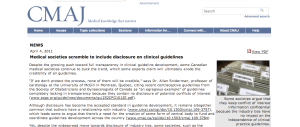MORE Magazine, May, 2011 — read more:
Category: Women's Health
New Evidence for Blood Clots With the Pill. Will Canadian Ob/Gyn Group Revise its Guidelines on Drospirenone?
April 26, 2011
By Kate Johnson
The Society of Obstetricians and Gynaecologists of Canada (SOGC) has a chance to redeem itself and make good on its controversial new contraceptive guidelines.
As I wrote in my last post, the guidelines are tainted with undisclosed conflicts of interest, calling their recommendations into question.
Now, two new studies in the British Medical Journal have made the guidelines redundant – presenting the SOGC with a rare opportunity to correct its mistakes (BMJ 2011;340:d2151 and BMJ 2011;340:d2139).Read More »
Can you Trust the Latest Canadian Contraceptive Guidelines? “The Bayer Facts” are Revealing in Their Omission.
April 4, 2011
By Kate Johnson
If it wasn’t for “the Bayer facts”, the new contraceptive guidelines from the Canadian Society of Obstetricians and Gynaecologists (SOGC) would be rather underwhelming.
But stripped down they are alarmingly revealing: “an egregious example of the extreme,” according to Dr. Allan Sniderman, a McGill University cardiology professor who has called for widespread medical guideline reform.Read More »
Canadian Contraceptive Guidelines Shun Disclosure
Mammography Screening – Are the Harms worth the Benefits?
November 16, 2009
By Kate Johnson
As I reported today, decisions about breast cancer screening just got tougher for women in their 40’s with today’s release of new guidelines from the U.S. Preventive Services Taskforce (USPSTF).
Backing off from its previous guidelines (2002), the task force now recommends against annual mammography for normal-risk women in this age-group, where it used to recommend for it. The new recommendation is to have the test every two years instead.
This is a major change from the task force, which is a leader in mammography screening guidelines. It goes against the recommendation of many other major U.S. groups, including the American Cancer Society, which is strongly critical of the USPSTF move.
So, why the disagreement?
It’s a debate over the harms versus the benefits of screening.Read More »
A New Way to Prevent Breast Cancer?
From Your Total Health, an NBC/iVillage website. Read more…

Egg Donation: Make me a Match
Published in MORE Magazine. Read more

